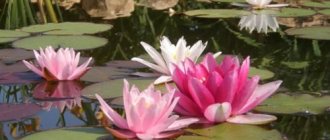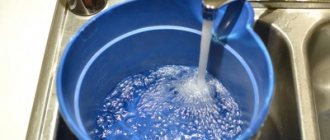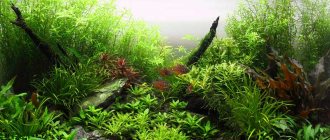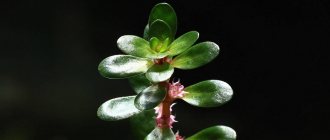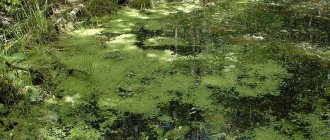The underwater world surprises with its diversity. Pondweed is an unpretentious plant and has an attractive appearance. It can be either perennial or annual, it all depends on the conditions of detention. A special feature of the species is its developed root system, which serves as a storage facility for nutrients and holds the plant in the substrate. Pondweed is very popular among both beginning aquarists and professionals.
Description and species diversity
In nature, pondweed is found in the fresh waters of South America. The plant has elongated, pointed olive-colored leaves and a thin, flexible stem. There are no petioles, the plates are located directly on the stem alternately. The height of the bush rarely exceeds 30 centimeters.
The following types of pondweed are used for aquariums:
| Name | Area | Description |
| Malay pondweed | Asia | Wavy long leaves. Thin stems reach the surface of the water. It reaches a height of 50 centimeters. This is the most whimsical look. |
| Floating pondweed | Waters of Russia and continental Europe | Perennial species. The length exceeds a meter. Resistant to temperature changes and droughts. It has floating and submerged leaves. The floating leaves are ovate or oblong-ovate, almost always heart-shaped at the base. They are dark green, leathery, opaque, with translucent longitudinal veins. They have a length of 5 to 10 cm, pointed at the ends and rounded at the base. Underwater grass-like structures called phyllodes are modified leaf stems. Stems are cylindrical, without numerous branches. The main difference between this species and other pond trees is the discolored flexible joint just below the top of the long leaf stem. |
| Gaia | Mexico, South America | An unpretentious plant. The bushes reach 30 centimeters. The color depends on the lighting: from green to brown. |
| Pierced leaf | North America, equatorial waters | Unlike most varieties, the leaves are round. Veins of contrasting color: from red to cherry. |
| curly pondweed | Europe | It grows very quickly and requires frequent pruning. The unpretentious appearance can withstand low temperatures. It got its name due to its wavy leaf blades. |
| Comb | Equatorial waters | The most unusual variety. The leaves are represented by threads that stretch up to 15 centimeters. |
Conditions for growing in a pond and aquarium
Pondweed grows well both in sunny and shaded places. As for the current, most species prefer slow-moving reservoirs or reservoirs with standing water. The soil in which the plant is planted must be nutritious.
It is recommended to plant “water cabbage” in ponds in summer. Species with floating leaves are suitable for shallow water, while species with submerged leaves require a depth of at least 20-30 cm. Plants are drowned to the required depth using a weight.
To prevent pondweed from taking over the entire pond, it is grown in containers. There is no need to remove it for the winter; it sinks to the bottom of the pond on its own and waits out the cold there.
Pondweed is very rare in an aquarium. To maintain it, the following water parameters are required: temperature 23-30 degrees, hardness dH 7-15, acidity pH 7-8. The soil should be silted. When planting in a freshly neglected aquarium, special nutritional tablets are placed under the roots of the plant.
Pondweed is propagated by seeds or cuttings. A cutting about 10 cm long is cut from the plant and planted in nutrient soil. The plant can be propagated by cutting the rhizome into several parts.
Let's look at the varieties of pondweed.
Maintenance and care
Despite the fact that this is an extremely hardy plant, certain conditions must be created for active growth.
| Options | Conditions |
| Aquarium volume | Perennial species require a lot of space. Before planting the plant, keep in mind: pondweed grows quickly and can block the vital activity of the inhabitants of the aquarium. The current does not play a primary role. |
| Water parameters | Despite its unpretentiousness, warm water promotes active growth. At lower temperatures, the plant immediately slows down its growth, and at temperatures below 22 ° C it stops growing and may die. The decorative qualities of the leaf plates depend on the hardness of the water. In soft environments, the leaves are small in size and dull in color. If this indicator is ignored for a long time, the plant grows very slowly. It is necessary to change up to 25% of the water volume at least once a week. |
| Light | Particular attention should be paid to lighting. Pondweed tolerates bright light better than shade. Choose lamps with a power of at least 0.5 W. The photoperiod must be at least 12 hours. Young plants react especially strongly to changes: in bright light the greens have a rich color. |
| Priming | Any soil will do. The optimal solution would be a slightly silted substrate: river sand, gravel with the addition of clay or peat. |
Elodea canadensis
Family Aquaticaceae, native to North America. Elodea canadensis is a plant completely submerged in water, much smaller in size than pondweed.
It has long, thin stems that spread along the bottom of the reservoir. They lie freely, without taking root. The leaves are elongated, transparent, oblong, have no petioles, located 3-4 on the stem. They form quite numerous whorls. The surface of the leaves is covered with a dirty, thin coating of lime.
Elodea canadensis belongs to flowering plants, however, very small flowers with whitish petals appear extremely rarely, in July-August. Propagated vegetatively by dividing stems. Growing quickly and strongly in natural bodies of water, it forms continuous thickets at the bottom, which is not desirable. Therefore, this plant is called water plague.
Reproduction and planting
Like most aquarium plants, pondweed reproduces vegetatively. There are two main ways:
- By stem cuttings.
- Dividing the root.
Under favorable conditions and the right substrate, pondweed grows quickly. The species belongs to stem plants and requires timely pruning.
While some plants can be pruned any way you want without affecting the growth process, others need to be pruned in a specific way or the plant will rot.
Pondweed needs pruning more often than any other aquarium plant, so you need to know how to do it correctly. Cut off the top two centimeters if they are no more than 50% of the existing length. To propagate pondweed, place the cuttings in the soil. As soon as the first roots appear, you can replant.
For propagation, it is better to use apical cuttings at least 20-25 cm long, since shorter ones develop very slowly. A cutting left to float may not produce roots for a long time, forming small side shoots.
Another method of artificial propagation is dividing the rhizome. Simply divide the root system into two parts and transplant into the substrate.
It is better to plant the plant in the warm season. In winter, pondweed goes into a dormant state and can even shed its leaves.
Why is pondweed useful?
- Potamogeton is an oxygenator herb that enriches water with oxygen and, as a result, bacteria do not develop in it.
- Pondweed flavonoids have hemostatic and anti-inflammatory effects, however, this has not been proven by official medicine.
- Fish such as grass carp, carp and crucian carp eat directly the leaves and shoots of pondweed. Larvae and fry use dense “mats” of pondweed leaves as shelter.
- Pondweed is an aquarium plant. Popular species for planting in the aquarium: pierced leaf, shiny, Canadian, Malayan, knotty, curly.
Why isn't it growing?
Like other living organisms, plants become susceptible to disease. In an aquarium, diseases can occur for many reasons, such as improper care, insufficient supply of nutrients, and unacceptable temperatures.
Symptoms include
- the plant changes its natural color, usually the leaves turn yellow;
- leaf blades rot and become damaged;
- the root system becomes damaged;
- the plant stops growing and slowly dies.
The main signs of diseases of aquarium plants and measures to combat them:
Stunting of plant growth: This occurs due to a lack of carbon dioxide (CO 2) or an unbalanced acid-base balance of water. Add CO2 to water. If the problem is pH related, move the plant to a different tank.
Small areas of leaves die, after which the leaves fall off: this is due to a lack of phosphorus. In this case, purchase special fertilizers for aquarium plants. They are available in pet stores.
Small leaves of plants, plants turn pale, thin stems; leaves at the bottom of the plant fall off: occurs due to insufficient lighting. Adjust the temperature and lighting mode; you need to extend the daylight hours, to do this, place the aquarium in front of the window.
Increase in the upper part of the length of plants: this is due to an increase in the radiation of the red spectrum of the lamps. Hang the lighting system higher, slightly closer to the lid of the aquarium, or purchase a less powerful lamp.
Damage to leaves, developed root system and small stem: the reason lies in excessively dense soil. Necessary measures: siphon the soil regularly, dilute it with gravel, pebbles, tuff and make it loose.
General preventive measures:
- It is necessary to maintain optimal conditions for the growth of aquarium plants.
- Clean the soil regularly and do partial water changes.
- Remove damaged parts of the plant in a timely manner.
- Place the aquarium in a place where there are appropriate lighting conditions.
- Always buy healthy plants from reputable aquarium plant sellers.
Maintain suitable water quality parameters such as pH, hardness, temperature and your plant will grow vigorously.
Pondweed - what is it, description of the plant
Pondweed is a perennial that grows in fresh or slightly saline water bodies. Extensive thickets, as a rule, form in stagnant and slowly flowing waters.
Main characteristics:
- Long rhizome. It develops and overwinters in the ground, and in the spring shoots sprout from the buds. Thanks to its developed root system, the plant not only attaches to the bottom, but also stores the necessary substances.
- Spike-shaped inflorescences of a marsh color. They can be seen above the surface of reservoirs in July-August. The flowers of most species are wind pollinated.
- Vegetative and seed type of propagation. Seeds are dispersed by birds or water.
- Regular leaf arrangement, variety of leaf shapes and sizes. They can be underwater or located on the surface.
- The ability of broken stems to continue their development.
- The stems and leaves of aquatic grass may become covered with a layer of lime that thickens over time. This crust is formed as a result of the processing of carbon dioxide. Dead shoots with a calcareous layer descend to the bottom and, decomposing, are transformed into fertile silt.
The leaves of some plant species are covered with droplets of oily liquid, due to which you can observe the effect of a greasy sheen.
There are several versions of the purpose of the substance:
- The plant acquires a pungent taste from it, which repels fish and slugs.
- The resulting oil is the deposition of reserve substances.
- The secretion of fat reduces the weight of the top parts of the pondweed and helps it stay upright.
Fertilizers
Pondweed does not need additional feeding. Moreover, the lime in the plant allows it to act as live food for the inhabitants of the underwater world. In agriculture, it is used as a substrate for seedlings, as well as a vitamin for pets.
Pondweed is considered an undemanding, hardy species that can grow successfully in a wide range of temperatures. It grows quickly, therefore, after acclimatization in a home aquarium, it begins to actively occupy all available space due to the rapid development of the creeping rhizome and the appearance of new shoots. It is better to use the plant to fill the background of the aquarium.
Useful properties of the plant
Pondweed has not been extensively studied, but in folk medicine it is used as a remedy that:
- strengthens the immune system;
- has a positive effect on the condition of the walls of blood vessels;
- thins the blood;
- normalizes the functioning of the digestive system;
- endowed with a hemostatic effect;
- resists inflammatory processes.
Pondweed is used to get rid of many diseases, including:
- arthritis;
- rheumatism;
- diarrhea;
- stomach diseases;
- intestinal disorders;
- furunculosis;
- skin diseases.
Collection and preparation of material
The quality and severity of the healing properties of the plant depend on the correct collection of material. Pondweed leaves are collected in the summer. After collection, they are washed well and cleaned of dirt. Next, put it in the shade and leave to dry.
After several days, transfer the collected material into paper containers, pack and store in a dry and dark place. The air temperature in the room should range from 20-24 degrees. The grass can be stored in this form for no more than one year.
Pondweed floating in the video:
Seed propagation of plants completely submerged in water
The seeds are propagated by pierced pondweed, brilliant pondweed, combed pondweed, and curly pondweed. The fruits of these plants, which are under water, in late August-early September, are collected while in a boat, picking them off with a hook.
The collected fruits are placed on the bottom of the boat, covered with damp moss, protecting them from drying out. The fruits are then placed in baskets or boxes with holes and dipped into water to fully ripen. After 7-12 days, the seeds, completely freed from fruit shells and mucus, are ready for sowing.
For sowing, the seeds are rolled into lumps of clay and lowered into clayey soil containing sand to a depth of 1.5 m. In the spring of next year, extensive underwater thickets of these plants are observed.
Meaning and application[edit | edit code ]
Types of pondweed are not of great practical importance.
They contain a lot of lime and therefore can serve as a fertilizer [6].
Pondweed feeds on aquatic mollusks, insects, and fish. There, in the thickets of pondweeds, on their underwater parts, and sometimes on the lower part of the leaves, they spawn.
Some types of pondweed serve as food for waterfowl, muskrats, and beavers. More often, fruits with a woody pericarp serve not so much for nutrition as for grinding food, being gastroliths.
The massive development of pondweed in water bodies impedes the movement of small vessels and contributes to silting and overgrowing of water bodies.
Pemphigus vulgare
Family Bladderwort, distributed throughout Europe. This is a perennial, highly branched, rootless plant. The stems, which reach 1 m in length, are completely submerged in water. On thread-like, repeatedly pinnately dissected leaves up to 5 cm long, there are many pale green vesicles with a diameter of 2-5 mm.
Each vesicle has a mouth opening; along its edges there are long, branched hairs and several stiff bristles. On the outside of the mouth there are many glands that secrete a sticky substance and sugar. This serves as bait for larvae, small crustaceans, daphnia, small worms, ciliates and fish fry. The valve opens even with a light touch, and, having caught the victim, immediately closes.
The inner surface of the vesicle is covered with glandular hairs that secrete enzymes to digest prey. Therefore, Bladderwort has the rare characteristics of flowering plants being completely submerged in water, like a carnivorous plant.
The flowers of the plant are orange-yellow, two-lipped, collected in a loose, irregularly shaped raceme. During flowering, the plant throws a loose brush onto the water surface.
Pemphigus vulgare reproduces vegetatively through wintering, spherical buds. It does not form dense thickets, so its feeding value is low. However, it is a favorite delicacy of ducks, in particular the red-headed duck. It is also used as a medicinal plant in medicine.
